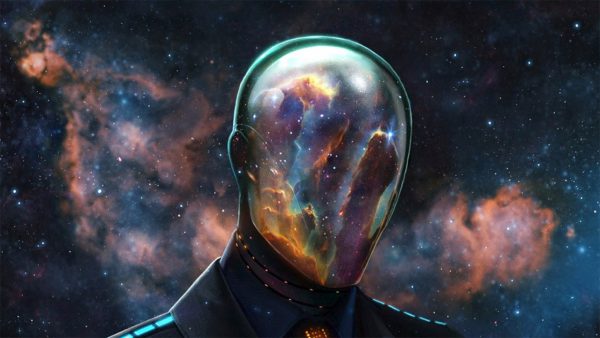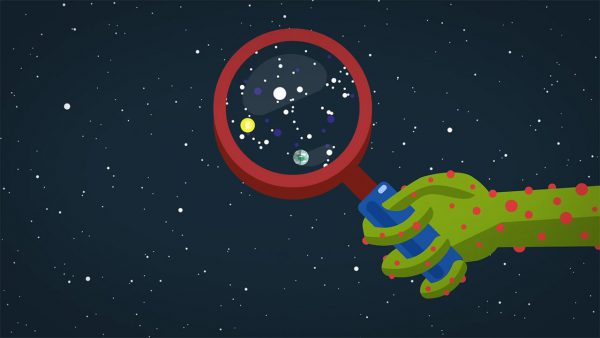I’m going to put some big numbers into perspective, you may want to be sitting down for this one. The Observable universe is 90 Billion light-years in diameter and holds about 100 Billion Galaxies. Each Galaxy has about 100 – 1000 Billion stars. Now that we are finding that planets aren’t as rare as we first thought we can expect that there are trillions and trillions of habitable planets in our universe. Therefore, shouldn’t the Universe be bursting at the seams with life, other than us?
This is the Fermi Paradox.

Named after physicist Enrico Fermi, the paradox contradicts the lack of evidence of life and the high probability of other life in the universe. But as we all know the Universe is a huge place, so let’s bring these numbers a little closer to home. Is it very, very likely that we will never venture to a galaxy far far away?
Even if we harness the speed of light, the universe is expanding at such a phenomenal speed that we will never ever reach anything further than our local galactic group. So, let’s look closely at our own Galaxy, The Milky Way.
Our Galaxy holds about 400 billion stars. To put that into perspective that’s about 10,000 stars for every grain of sand on Earth…Take a second to think about that one…
Out of those 400 billion stars, about 20 Billion are similar to our Sun. Let’s say 1 out of every 5 stars had a planet in the Habitable zone, and that 0.1% had life. There would still be 1 million planets in our galaxy with some level of life.
The universe is 13.8 Billion Years old and the Earth is only 4.5 billion years old with evidence of life dating back as far as 3.5 billion years ago. After the Big Bang, we can assume that the Universe was very hostile however settled down after the first few billion years. However, life on older planets may have gotten a head start and could be billions of years older than our planet. Plenty of time for it to evolve into a species as intelligent or civilised as humans.
Civilised race billions or millions of years more advanced than humans could have easily harnessed greater advancements in technology. If we on Earth were able to build spacecraft that could sustain the human population for 1000 years we would be able to colonise the Milky way in only 2 million years. There has been plenty of time for a civilised alien race to colonise the galaxy.
So then, where are all the Na’vi, Klingons and Ewoks?

Created by Soviet Astronomer Nickolei Kardashev in 1964, the Kardashev scale determines the level of technological advancement of civilisation based on the way they harness energy.
A type I civilisation has harnessed all the energy that falls on their planet from their star. Type II has harnessed all the energy of their star, and Type III has harnessed all the energy of their Galaxy. According to Physicist Michio Kaku Humans will attain Type 1 status in about 100-200 years, type II Status in a few thousand years and type III in 100,000 years to 1 million years. There have been a few discoveries that have led us to believe that type 1 and 2 civilisations are out there in our galaxy however they have been quickly debunked.
On October 14, 2015, the detection of an unusual light curve for star KIC 8462852 raised speculation that a Dyson Sphere (Type II civilization) may have been discovered. The SETI Institute’s initial radio reconnaissance of KIC 8462852, however, found no evidence of technology-related radio signals from the star.
In 2016, Paul Glister, author of the Centauri Dreams website, described a signal apparently from the star HD 164595 as requiring the power of a Type I or Type II civilization, if produced by extra-terrestrial lifeform. However, in August 2016 it was discovered that the signal’s origin was most likely a military satellite orbiting the Earth.
This leads us to think, why hasn’t an alien race attempted to contact us, and is it probably a good thing they haven’t? There are many different speculations by very prominent scientists and is worth a Google on your lunch break. Below are some of the more popular, common and conspiracy speculations.
Perhaps we have already been visited? The earth is quite young compared to a lot of the Galaxy, and maybe intelligent life arrived here, had a look at the primitive sea molluscs and went on their way. Or maybe they stopped sending out their communication transmissions in our direction because, well, as far as we know dinosaurs aren’t that great at detecting and translating interstellar radio messages.
Perhaps we have the messages right now but have not developed the technology to detect them? Who knows how another civilisation developed their technology, they may be sending messages in the form of light from their Sun, while we are busy with radio waves and we totally miss each other. Or perhaps the information we have is interpreted incorrectly.
Perhaps they are already here walking on this Planet, however exist in a dimension we are yet to discover? Perhaps they entered our minds when we’re primitive apes and the Aliens are a parasite that thrives off our brain energy. Wait, am I getting too close to Scientology here?
Perhaps we are in the sticks? We might be the Perth of the galaxy and just so isolated that it’s just too much of a hassle for an alien race to head out here. IF this is the case there may be numerous civilisations all working together in the popular parts of the galaxy but when they look out to our side of the spiral, there are just too many risks of running out of supplies or energy to get back. Maybe our solar system is on an interstellar bucket list. Just no one has gotten around to it yet.
Maybe they exist in a virtual world and never venture from their minds rather than their planet. If everything they desire is simulated, then will never search for what they desire. Like the Matrix, when we are all plugged into it we have no need to explore the real universe.
Perhaps they are just too Alien. Ants are amazing as a species. The way they work as a network and as one collective ‘brain’ is far more advanced than the way humans work together. But we cannot communicate with an Ant. In fact, if an ant colony is in the way of a garden refurb or a building development most humans will destroy them without a second thought. We cannot relate to them and our level of intelligence is so superior to them (or so we believe) that as a species we get preference. Now imagine if we were the ants, and our planet was in the way of some major intergalactic development, a la Hitchhikers Guide to the Galaxy, they would destroy us without a second thought and there would be no way we could communicate on their level to save our skins.
And that leads us to a few more depressing speculations.
Perhaps there is a superior Alien race, and it’s watching us and waiting for our technology to advance, to a level where they steal it and destroy us all. Maybe they are waiting for us to turn into a type II civilisation and they colonise and enslave us all after we’ve done all the hard work.
Another depressing thought is that maybe intelligent life is doomed by its own advancement and the reason there are no aliens is that they all got to a point where they destroyed themselves and humans are just on the same path. Perhaps becoming a type 2 civilisation requires technology that destroys the planet, and as Kaku predicts, we will get there in 1000 years.
The thing is we just don’t know, and we may never know and maybe it’s better and safer that we do not. We have equations to back it all up, (The Drake Equation) but no physical evidence. As Author of 2001 Space Odyssey and futurist Sir Arthur C Clarke has famously said.
Two possibilities exist: Either we are alone in the Universe or we are not. Both are equally terrifying.





